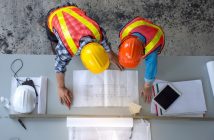Tunnels that carry road, rail and utility services are usually built to minimise the cost and time it takes to move people, freight and services around a city or country

Many are built underground or through mountain ranges in order to minimise the cost of going over or around them.
The longest road tunnel in the world is currently the Laerdal Tunnel near Bergen in Norway and the longest rail tunnel is the Gotthard Tunnel that was bored through the Swiss Alps.
New Zealand’s longest tunnel is the nine kilometre long Kaimai rail tunnel near Apata while in Australia both the longest road and rail tunnels are part of high speed links to airports: rail in Sydney and road in Brisbane.
Tunnels, however, are not a modern idea; they have been an important part of public and private infrastructure for millennia.
Archaeological digs through Roman ruins have uncovered evidence of tubular brick- and tile-lined hypercausts and aquifers running beneath towns and roads.
Tunnels are mostly of two types of construction, the less expensive of which is referred to as “cut and cover” where a trench is dug and the road or rail or services are installed.
A roof is then placed over the trench and the ground reinstated and landscaped.
The alternative is to manually or mechanically dig through rock and soil and then line the inside of the tunnel with concrete for strength and stability.
The road, rail or services are built or installed behind the advancing end of the tunnel.
A common design for modern tunnels is to use a boring machine to dig through the ground substrate.
The development of large, mechanical machines in the mid-20th century, simplified construction of underground tunnels.
Initially, the concrete linings were cast in situ behind the excavating machine head as it worked its way slowly forward.
Today, pre-cast reinforced, high-strength concrete panels are delivered to site and mechanically placed around the circumference in an interlocking pattern.
Such a method is vastly different to that employed in the construction of London’s Tube, where many of that network’s older tunnels are beautiful, hand-built, brick lined constructs.
Rob Kilgour, Principal Engineer for Materials Technology at leading global engineering consultancy WSP, whose role covers durability planning and material selection for new projects, says that the use of precast concrete panels greatly improved quality assurance as the pieces were prepared under controlled, factory conditions.
As a tunnel is dug, a water-resistant lining system is installed to provide structural support and waterproofing.
The concrete elements may be either in situ or precast panels.
Polymer membranes may be placed prior to installing the concrete lining—typically an approach used for cast in place linings.
Where precast segments are used, a rubber gasket is used to prevent water ingress between the segments.
The gaskets are made from ethylene propylene diene monomer (EPDM) rubber.
Kilgour adds that it is not just the physical route that has to be checked.
“When we build through brownfield sites it is essential to conduct a thorough analysis of the soil to check for contaminants,” he explains.
“Hydrocarbons often leak into the ground around and under industrial plants and petrol stations which can damage waterproofing membranes and the rubber seals between concrete segments.”
City challenges
Building under a large modern city—such as Melbourne, Auckland, or Dubai—presents many challenges to the construction company delivering the project.
The route must be carefully planned so as to avoid other infrastructure such as pipelines for gas, water and other utilities, building foundations and existing transport tunnels.
When the Victorian government approved the underground rail tunnels and stations in Melbourne in the 1970s, planning the route had to take the railway deep enough to avoid much of the infrastructure and around or through the footprint of some the city’s tallest buildings.
The challenge of avoiding existing transport tunnels was highlighted in the English Crossrail project when the excavating and concrete handling equipment passed just 450 mm above the roof of a platform of one of the Tube’s largest and busiest stations.
One project Kilgour worked on was the underground metro train system in Dubai. “We carried out a baseline survey of all the buildings in the oldest parts of Dubai to make sure that we could prove that the tunnelling works did not cause any damage to buildings and property adjacent to the route.”
The different types of tunnelling systems are very dependent on the nature of the ground conditions.
Tunnelling through sand presents different challenges to those encountered when working through mud and rock.
“A variety of techniques can be used in terrain that is soft,” Kilgour explains.
“These include techniques such as ground freezing or emulsification that increase the density of the ground and allow excavation and construction of the tunnel lining to be completed before the ground softens again.”
To this day, one of the greatest tunnel engineering feats is the nearly 2,000 kilometres of sewers that were dug by hand under London almost 160 years ago.
Designed by Joseph Bazalgette in the mid-19th century, the system remains a masterpiece of Victorian engineering.
There are approximately 132 kilometres of main sewer where the diameter is large enough for a man to comfortably walk upright in them; while public tours were stopped decades ago, if you know the right people, it is still possible to be taken into the tunnels beneath the busy streets of central London.
Today, infrastructure requirements often call for a life expectancy of 100 years, so durability planning is starting to be incorporated into the whole design process.
According to New Zealand-based Nickel Institute Consultant Les Boulton this was not always the case.
“During much of the 20th century, it was often the case of constructing a project as cheaply as practical and letting others worry about paying for the maintenance.”
In the past, little thought was given to materials selection for durability or the potential impact this may have for the asset owners in terms of ongoing maintenance costs.
This resulted in a modest construction cost but very expensive continual monitoring.
Too often it was a matter of putting up with a repeating cycle of repair and replace after a structure had been built.
Boulton adds: “However, engineering graduates are now being taught—and then putting into practice—the concept of lifecycle costing.”
Durability planning provides a method for assessing performance requirements specific to the prevailing exposure environment and required design life and controlling material selection so that the appropriate strength and grade of materials are procured and used for construction.
“In modern road and rail tunnels there is a large amount of machinery and equipment that the users rarely notice.”
This equipment includes large jet fans that circulate the air in the tunnel, fixed and interactive signage, as well as the trays and brackets supporting service ducts and cables.
Long life
All inaccessible or unmaintainable equipment and attachment points must be designed to last up to 100 years.
According to Boulton, designs call for stainless steel to be used for casings and fixings.
Pipes for a range of services and utilities as well as servicing tunnels and large stormwater drains are often placed under the road or rail deck, in the space referred to as the “tunnel invert.”
Most tunnels—rail, communication, utility or service—are usually bare concrete because owners don’t value aesthetics.
“Road tunnels are often painted or tiled to give a pleasing pattern that breaks up the monotony of the view for drivers,” Boulton addds.
Safety has also contributed to the move away from cheaper project options.
A multi-vehicle crash deep inside one of the many tunnels through the Swiss countryside in the 1980s resulted in many deaths and a fire that burned for a days.
The insides were made of steel with a corrosion protection coating.
Carbon steel starts to yields at 350 degrees Celsius at which point structures can start to fail under their own weight.
“You can’t get excellent durability and strength from steel and paint,” Boulton says.
“Everyone involved has to sign up to the planning for durability and safety.”
In contrast, stainless steel can withstand temperatures of 1000 degrees Celsius.
Specifying corrosion resistant stainless steel is more expensive as a construction cost, but greatly reduces the ongoing maintenance costs.
“Specifying durable materials has been slow to be adopted because maintenance traditionally is treated as an expense and is accounted for differently,” Boulton says.
To support industry, the Australasian Corrosion Association (ACA) works with private companies, organisations and academia to research all aspects of corrosion such as rubber degradation from hydrocarbons.
The ACA provides an extensive knowledge base that supports best practice in corrosion management, thus ensuring all impacts of corrosion are responsibly managed, the environment is protected, public safety enhanced and economies improved.




